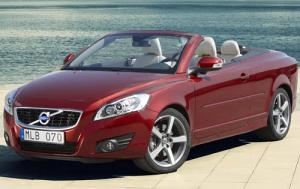- Save |
- Email |
- RSS |
- Newsletter

New Models
-
2011 Volvo C70 MSRP from $39,950
 View photos
View photos
Used Models
-
2010 Volvo C70 Used TMV from $33,525 Find Used Inventory
 View photos
View photos
-
2009 Volvo C70 Used TMV from $28,306 Find Used Inventory
 View photos
View photos
-
2008 Volvo C70 Used TMV from $25,562 Find Used Inventory
 View photos
View photos
-
2007 Volvo C70 Used TMV from $22,190 Find Used Inventory
 View photos
View photos
-
2006 Volvo C70 Used TMV from $18,429 Find Used Inventory
 View photos
View photos
-
2004 Volvo C70 Used TMV from $11,452 Find Used Inventory
 View photos
View photos
-
2003 Volvo C70 Used TMV from $9,098 Find Used Inventory
 View photos
View photos
-
2002 Volvo C70 Convertible Used TMV from $7,890 Find Used Inventory
 View photos
View photos
-
2002 Volvo C70 Coupe Used TMV from $6,848 Find Used Inventory
 View photos
View photos
-
2001 Volvo C70 Convertible Used TMV from $6,398 Find Used Inventory
 View photos
View photos
-
2001 Volvo C70 Coupe Used TMV from $5,225 Find Used Inventory
 View photos
View photos
-
2000 Volvo C70 Convertible Used TMV from $5,621 Find Used Inventory
 View photos
View photos
-
2000 Volvo C70 Coupe Used TMV from $4,697 Find Used Inventory
 View photos
View photos
-
1999 Volvo C70 Convertible Used TMV from $5,214 Find Used Inventory
 View photos
View photos
-
1999 Volvo C70 Coupe Used TMV from $4,237 Find Used Inventory
 View photos
View photos
-
1998 Volvo C70 Convertible Used TMV from $4,851 Find Used Inventory
 View photos
View photos
-
1998 Volvo C70 Coupe Used TMV from $3,797 Find Used Inventory
 View photos
View photos
In years gone by, Volvos were known as boxy, square lumps -- reliable and safe, perhaps, but never a styling trendsetter. The Swedes finally joined the styling parade in the late '90s with the introduction of the slightly more curvaceous Volvo C70. Available as a coupe or convertible, the two-door C70 shared much of its underlying hardware with the S70 sedan of the time. Detail improvements through the years -- including trim level and color changes, and minor engine upgrades with low- and high-output turbo options -- kept the first-generation C70 fresh enough for its relatively low volume of customers.
A fully redesigned Volvo C70 debuted for 2006, and it was a whole new ball game. Rather than offering separate coupe and convertible models, Volvo decided to join the herd again and offer a handsome new retractable hardtop that opens and closes at the touch of a button. Fortunately, the attractive shape of the first C70 has largely carried over to the second. The C70 is no sports car, but it should appeal to those who want style and comfort in a luxury convertible.
Current Volvo C70
The Volvo C70 is based on the same platform used for the S40 sedan and V50 wagon. It comes in one body style only -- a convertible with a power-retractable hardtop. When the C70's steel roof is up, it gives the car coupelike styling, added rigidity and better noise isolation than a soft top. When the roof-lowering process is started, the C70's dual-hinged trunk lid opens in a reverse motion and the roof pieces arc backward and stack inside the trunk. Overall, the process is seamless and takes about 30 seconds to complete.
Available in only one trim level, T5, the C70 comes well-equipped with most modern convenience features, including alloy wheels, power seats, dual-zone automatic climate control and Bluetooth. A few option packages allow one to add items such as leather seating, a navigation system and an upgraded audio system. For power, the C70 relies on a turbocharged 2.5-liter inline five-cylinder engine developing 227 horsepower and 236 pound-feet of torque. Power is sent to the front wheels through a standard six-speed manual transmission, with a five-speed automatic available. Though acceleration is certainly not blistering, the turbocharged engine provides enough low-end torque to get the C70 moving briskly from a stop.
Our editors agree that consumers interested in a comfortable four-passenger convertible should take a close look at the Volvo C70 T5. Pricing might be a concern for some, as the C70 occupies the same price point as more fun-to-drive European and Japanese competitors. Still, a strong case can be made for the C70 given its attractive design, long list of safety equipment and comfortable ergonomics.
Used Volvo C70 Models
The present second-generation C70 debuted in 2006. Notable changes since then include a slight power bump in 2008 from 218 hp to 227 hp. Prior to 2009, Bluetooth was unavailable, and the C70's optional navigation system was not hard-drive-based and lacked some of the current system's features.
The first-generation C70 appeared in 1998 as part of Volvo's effort to polish its brand image with a bit of style and desirability. Two models, a two-door coupe and a two-door convertible with a traditional soft top, were initially available. This first C70 was comfortable and competent, with attractive and elegant styling, but we found its uninspiring underpinnings made it a rather bland car to drive, particularly in comparison to hotter European coupes or convertibles. For power, Volvo installed either a 236-hp turbocharged inline five-cylinder engine or a less powerful 190-hp version.
Minor equipment changes carried the Volvo C70 through its first few years. The 190-hp engine was originally available on the coupe but then dropped in 2001. The high-output engine wasn't available on the convertible until 2000. In 2003, Volvo discontinued the C70 coupe; convertible production ended after 2004. At the time, we found the C70 to be generally desirable, though its dated underpinnings put it at an increasing disadvantage against fresher competitors as the years went on, especially in terms of handling performance.
Research Models
Advertisement
New Car Resources
Advertisement
Advertisement
Recently Viewed